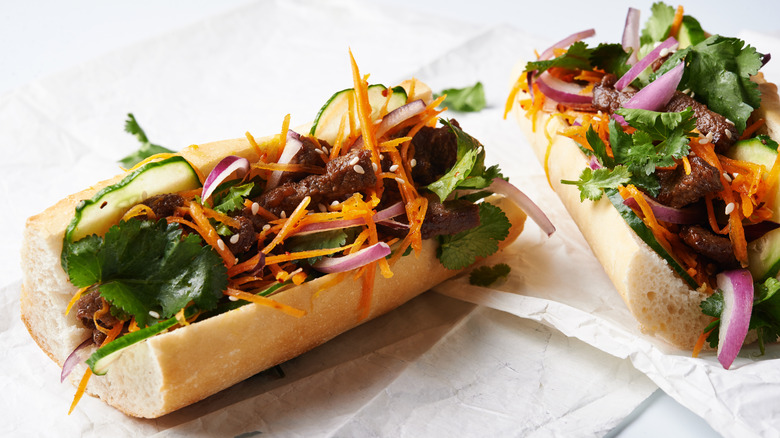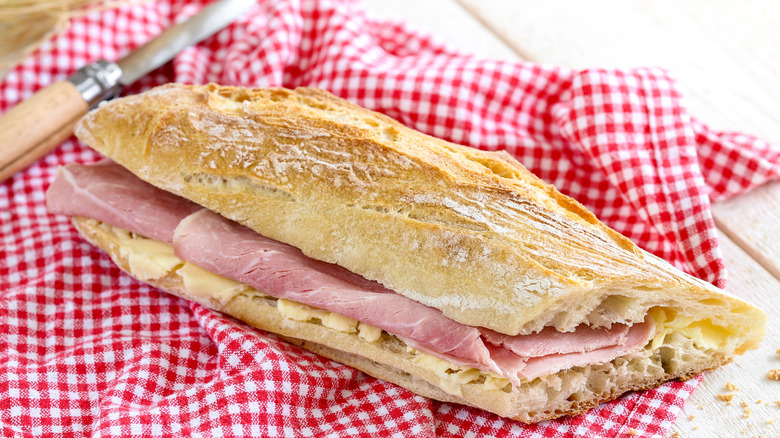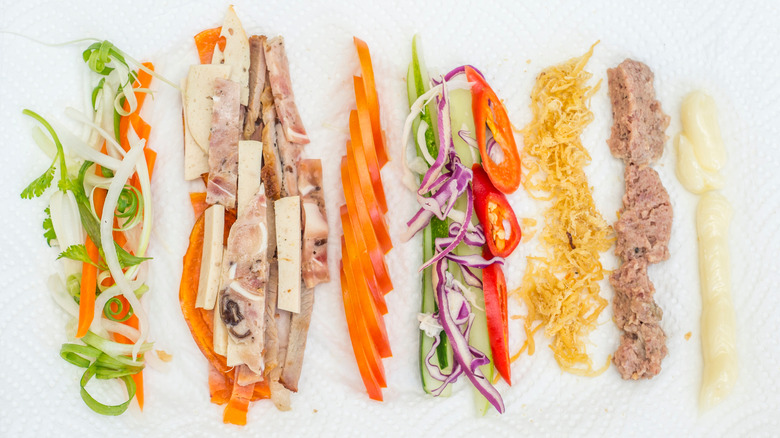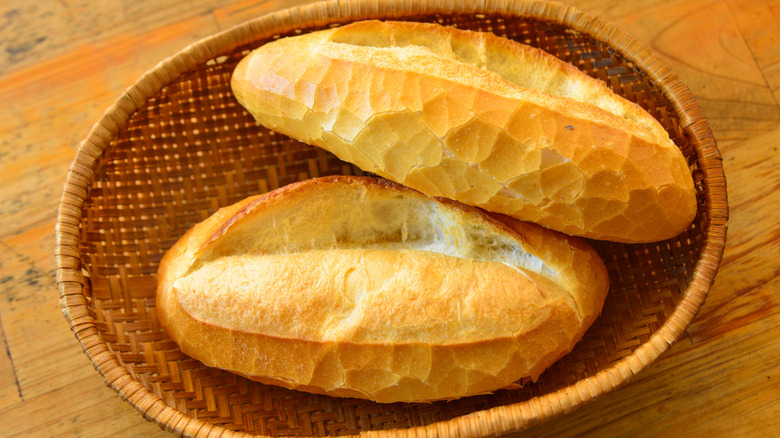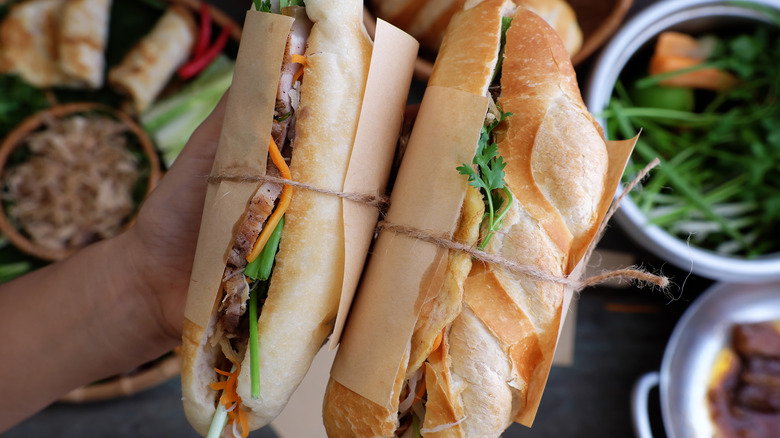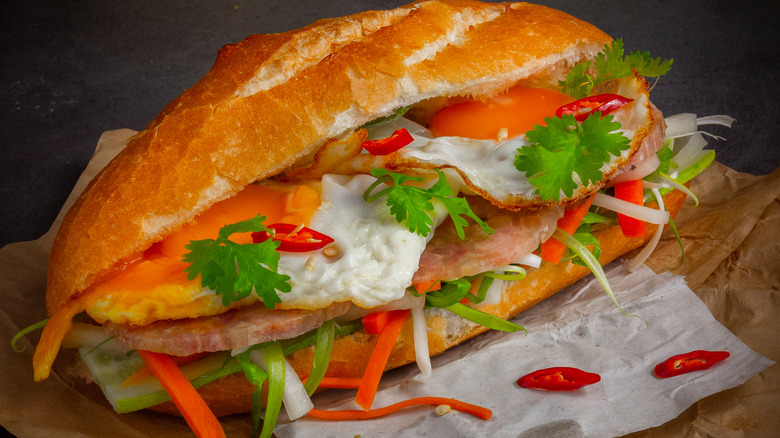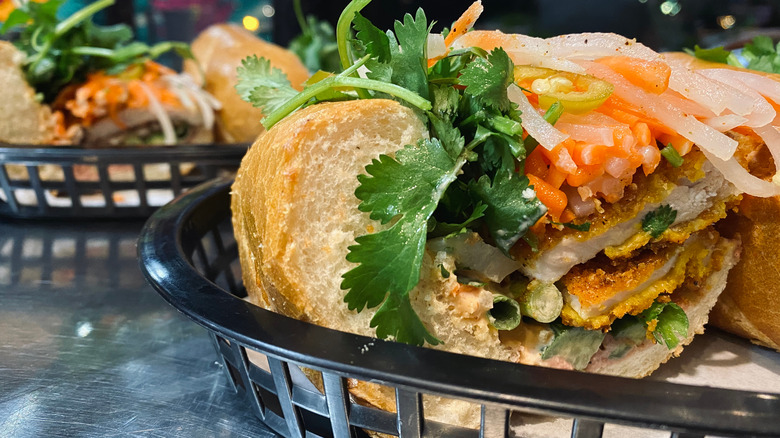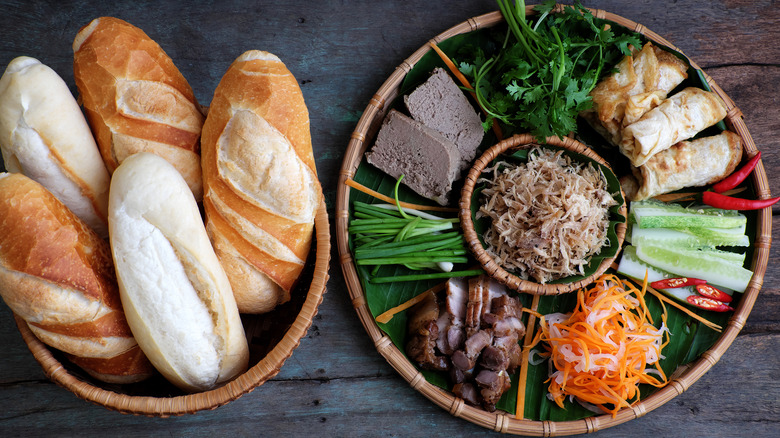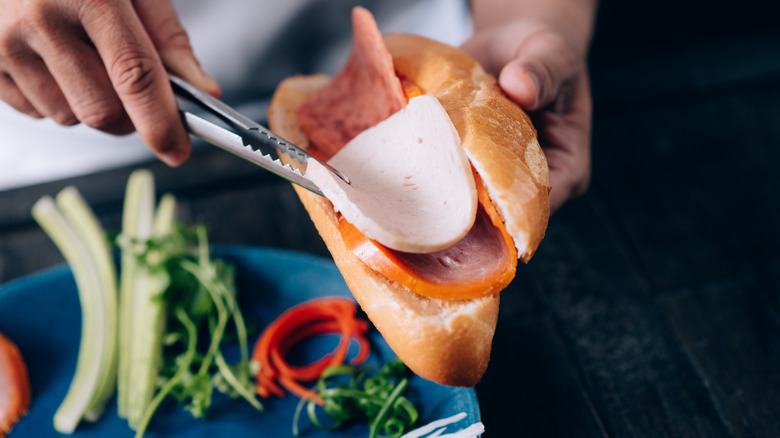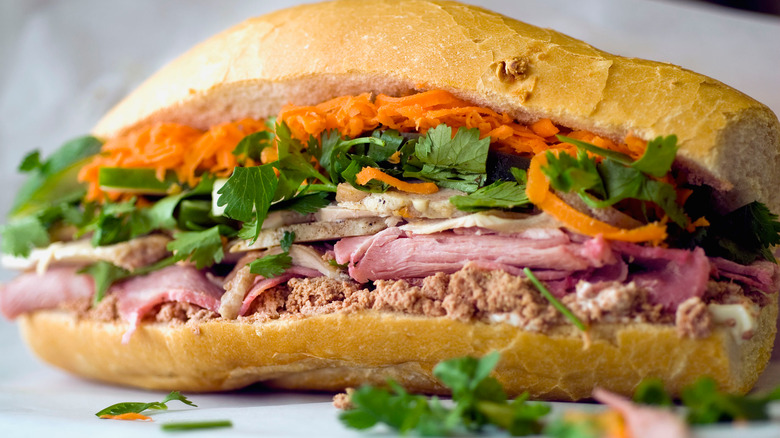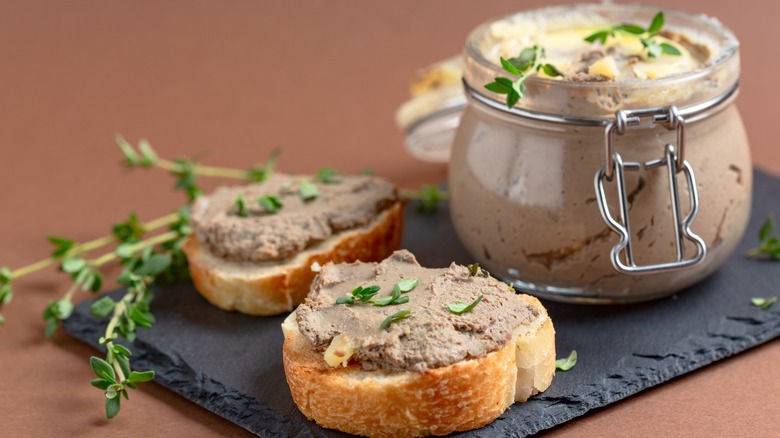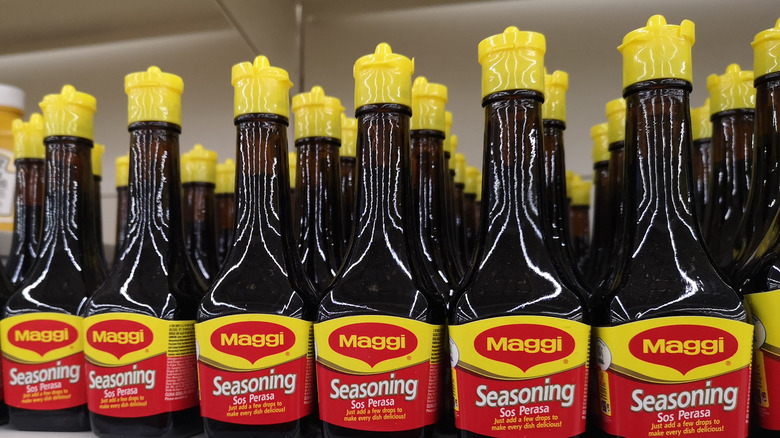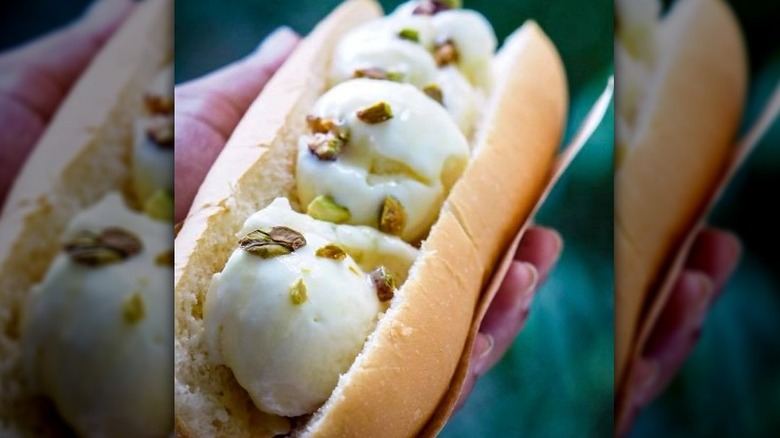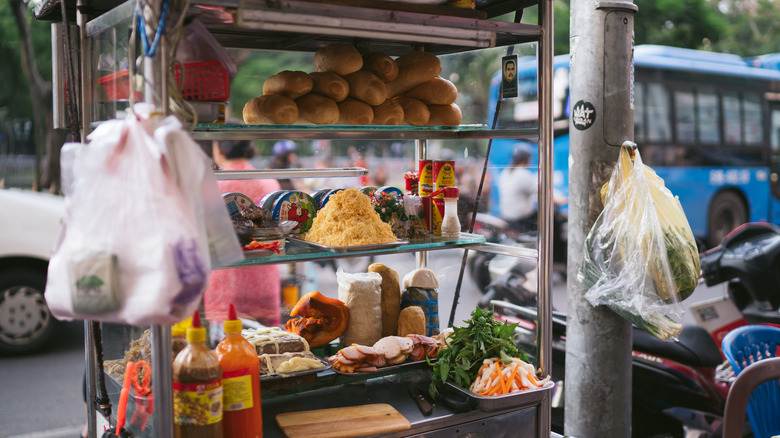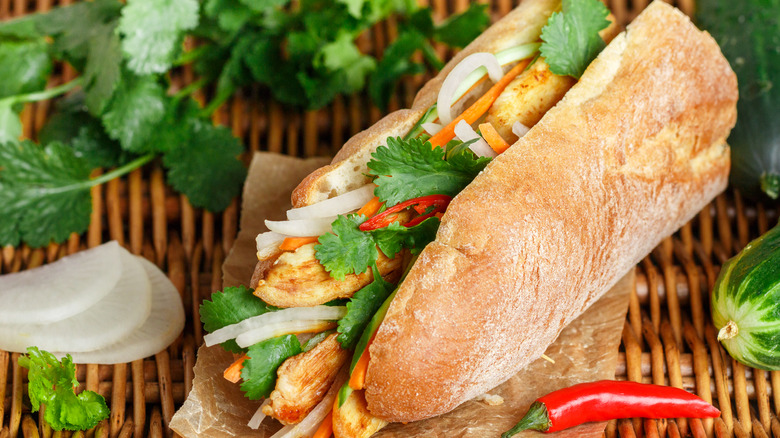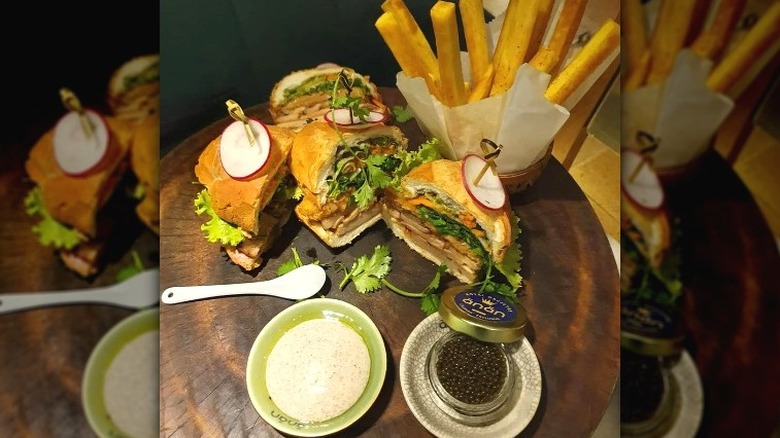The Untold Truth Of Banh Mi
Every culture has its variation of the sandwich — in Germany, it's Toast Hawaii, in Japan, it's the fruit sando, and Mexico loves the pambazo (via CNN). There's just something enticing about grab n' go, especially with today's "always on the go-go-go" mentality. A good sandwich is filling — but not so much that you're hit with a food coma — and can properly fuel you until your next meal time. If constructed correctly, it shouldn't get all over the place (no one likes displaying a huge oil spot on their shirt), and ideally allows you the freedom to multitask as you're eating. You know, sandwich in one hand, responding to emails, texts, and calls with the other. (Or, you know, checking out the latest food news on Mashed.)
Perhaps that's why the banh mi has become such a popular sandwich not just in the United States, but globally (via Vietnam Drive). This humble and celebrated street food wasn't always available to the global masses — in fact, it wasn't even really available to the Vietnamese (in its birthplace) for decades! The banh mi has only really gained legendary status within the past 30 to 40 years, but its popularity continues to grow. According to the Richmond Pulse, every city in North America now has at least one banh mi shop or chain. (And the same goes for pretty much every other developed nation.)
But what's really going on with this delectable fusion food? Its storied history might surprise you.
The original French banh mi was basically a ham sandwich
When the French colonists came to Vietnam, they made sure that all of their necessary foods were also readily available to them, which meant importing them directly from France (via South China Morning Post). One of those adored, staple dishes was a simple sandwich known as Jambon-beurre, which translates to ham and butter. This was a true comfort food for colonists living in Vietnam. While a basic ham and butter sandwich was a beginning source of inspiration for the banh mi — and a nice memory of home for the French — another meal that probably had some weight on the evolution of the banh mi was the French charcuterie board.
At its most rudimentary level, a charcuterie board contains bread, butter or spread, meat, and cheese. In the 1800s, the French colonists were also living it up with the addition of liver pate, possibly foie gras, pickles, fresh vegetables, and decadent spreads like jam, mustard, and mayonnaise. That being said, charcuterie was only served to the French colonists and was available only at high-end restaurants and cafés. Charcuterie wasn't something that the Vietnamese could afford. So in a sense, the charcuterie can be likened to a build-your-own sandwich station, which is why it's easy to see how the banh mi could take inspiration from it.
A true Vietnamese banh mi contains a few core ingredients
The everyday, traditional Vietnamese banh mi is pretty basic when you get down to the core components. Some restaurants will tote sandwiches that have everything under the sun shoved into a bun but are actually missing important things like the proper bread or herbs and seasonings.
When it comes to the banh mi, it has to have the ubiquitous baguette as its holding element, but this bread has to contain 50% wheat flour and 50% rice, writes travel blog Vietnam is Awesome. Once you've got the bread down, your sandwich will need mayonnaise (or butter), some type of filling (like pork, chicken, or tofu), fresh vegetables (typically cucumbers) as well as the pickled variety (daikon and carrots), and lastly, a few condiments to add a bit more flavor (like soy sauce, fish sauce, or Maggi seasoning).
It's a simple, no-frills sandwich that utilizes all five of the different tastes: sweet, salty, sour, bitter, and umami. It also combines different textures, because as tasty as a slice of American cheese on untoasted white bread is, you have to admit that it's a bit boring.
It's all about the bread
While there may be innumerable variations of this sandwich, the one constant is the bread. How important is the bread? Well, banh mi actually means wheat bread (via Merriam-Webster), though the first thing we think of is the sandwich as a whole. But what's so special about this bread is that it's not your typical French baguette.
In a nutshell, in the mid-1800s, the French decided it was their humanistic duty to help Vietnam grow from an uncivilized and impoverished country to one more in line with European cultural ideals and philosophies (via Alpha History). Because Vietnam didn't have any of the required French ingredients for proper meals and whatnot, colonists had theirs shipped over from the motherland. The French introduced items like flan, pate, foie gras, coffee, and the baguette into Vietnamese cuisine, as noted by The Culture Trip.
As you can imagine, WWI and WWII both put a bit of a damper on the importation and exportation of consumables and goods, which meant having to make do with what you had and learning how to improvise (via Vietnam is Awesome). One of these items that underwent metamorphosis was the French baguette, which began using a 50/50 blend of wheat and rice flour (as opposed to only wheat). The tasty result of this new recipe was a lighter, flakier, less dense, and somewhat hollow Vietnamese-style baguette that was perfect for the reinvention of the banh mi.
There are actually two main types of banh mi
When it comes to ordering the perfect banh mi, you're going to be presented with a whole host of flavorful fillings and toppings. That being said, there are actually only two categories (or styles) that a banh mi falls under: Northern style and Saigon style (via The Shorthorn).
Northern style banh mi contains just a few ingredients, like butter, pate, salt and pepper, and maybe a random cucumber or errant spring of cilantro. It's basically just bread and spread with light seasoning. Northern style banh mi is probably most akin to what the French colonials were scarfing down back in the day (via Vietnam is Awesome).
Saigon-style is the more well-known of the two and is typically what you think of when you hear banh mi. It's basically the "everything under the sun goes in this bread pocket" sammie and generally contains one or two protein fillings, fragrant herbs, fresh and pickled vegetables, one or more spreads (like mayonnaise and pate), a spice element like sliced jalapeños or other fiery chilis, and more.
There's a sandwich for every meal
As noted in the excerpt from The Cairo Review, the banh mi is typically enjoyed for breakfast or as a midday snack. That might sound a bit odd, considering that the standard sandwich can usually incorporate pate and pickles. However, it's not uncommon to find these ingredients incorporated in breakfast around the world. For example, in Japan, the typical breakfast can include fish, miso soup, rice, and pickled vegetables, while the folks down under enjoy a healthy bowl of farro topped with a poached egg and pickled veggies (via CNN). The European Restaurant states that cold cuts and pate are normally part of the breakfast circuit for Germanic and Baltic countries.
But there is an actual banh mi specifically designated for breakfast — although it's a well-known fact that breakfast can (and should) be enjoyed at any time of the day — and is sort of the equivalent to a fried egg on toast. According to the travel blog Backpacker Lee, the breakfast banh mi is a buttered baguette with scrambled or sunny-side-up eggs, onions, and a smidge of soy sauce. Sounds tasty enough.
It's wholesome and super filling
The banh mi is considered to be an incredibly filling and relatively healthy meal (via On the Gas). Keep in mind that this sandwich isn't like what you'd find at a chain restaurant. (You know, a sandwich that's probably going to be a greasy gut-bomb, responsible for lulling you into a food stupor instead of fueling you to carpe your diem).
The banh mi is a simple sandwich made with basic and (mostly) healthy ingredients. Sure, it's white bread. But it's a 50/50 blend of wheat flour — which is high in dietary fiber and low in gluten — and rice flour, which is not only high in fiber and protein, but is safe for gluten-intolerant individuals (via Live Strong). There's the necessary protein, which helps build muscle mass (and is better at doing so if eaten in the morning, as noted by Medical News Today). The banh mi also has fresh veggies and herbs — which you already know are good for you — as well as pickled vegetables, which help control blood sugar and restore electrolytes.
There's a specific way to assemble it
Just like any other sandwich, burger, or even the universally beloved burrito, there's a specific protocol you need to follow in order to assemble a banh mi (via NPR). Of course, it depends on how much you're going to be stuffing into that fluffy little baguette, but each ingredient has its own designated spot in the line-up. This formula creates a fully functional sandwich, meaning it won't squish out the top, bottom, or sides. (Which is good because the last thing you want is to ruin your new suede cruisers.)
It's essential that the bread is fresh and warm, according to the travel blog Vietnam is Awesome. Once you slice it down the middle, spread mayonnaise all the way to the edges of the bread, then sprinkle it with the Swiss condiment Maggi Seasoning. After that, add your protein of choice, pate (if desired), and then top it off with crunchy pickled daikon and carrot, sliced cucumber, fresh herbs like cilantro, mint, or basil, and some jalapeño. Wrap it up or eat it right then and there. No matter what, it'll be happy tummy time.
The most popular banh mi is called the Special Combo
When it comes to ordering a banh mi, you can choose from a whole multitude of different protein fillings: pork, beef, chicken, fish, tofu, fried egg, ice cream. Okay, so ice cream isn't a protein, but it just proves the point that whatever you want on your banh mi, you can probably get. While you'd think that something like barbecued or grilled pork, or even pork belly, would be the clear winner overall, you're going to have to guess again (via Battle of the Banh Mi).
Unarguably, the most popular banh mi also has the closest ties to the original French colonial sandwich. It's called the Special Combo, or sometimes the House Special (via Vietnam is Awesome). Whichever guise it goes by, all you need to know is that it's special. The Special Combo is like a riff on a French charcuterie board, which typically has bread, butter, pate, and cold cuts. (It's basically a deconstructed sandwich). That being said, the Special Combo is pretty much a cold-cut sandwich, filled with a combination of any of the following: cold cuts, ham, headcheese, rolled pork, salt-cured pork, or Vietnamese pork sausage. Of course, there's the pate, as well as the ubiquitous crunchy pickles, fresh cucumber and cilantro, your seasoning of choice, and also a spice element (should you wish to have one).
Pork is the most prominent protein filler
After pursuing the multiple different protein fillings that can grace your banh mi, you might notice that a majority of them are pork or pork-based. This is because pork is not only inexpensive but, according to Statista, is also the main protein consumed in Vietnam (poultry comes in second). The pork-centric blog Pig 333 (Professional Pig Community) notes that as of 2018, Vietnam was the sixth leading pork producer in the world.
This little piggie is no joke when it comes to the number of different applications available for a banh mi. You know how Bubba from Forrest Gump has hundreds of ways to prepare shrimp? Well, it's kind of like that, but with pork instead of shellfish. You can get grilled pork, pork patties, pork meatballs, shredded pork, pork headcheese, pork belly, pork skin, pork pate, pork cold cuts, rolled pork (pork that's been rolled up in a banana leaf and steamed), barbecue pork, and sour pork ... to name a few.
Pate is still a popular condiment
You might think that pate is reserved for the elite, or for those of us who enjoy expensive charcuterie, lavish parties, and rich meats and cheeses. Well, it pretty much was reserved for those types of folks (back when France was trying to "improve" Vietnam by forcing them to practice Christianity, occupying their land, governing them without their consent, ordering them around like a bossy sibling ... you know, the somewhat unsavory side of history).
Back in the mid-1800s, the pate French colonialists were eating was typically made with either chicken or goose liver, which the Vietnamese found to be far too rich — and also far too expensive (via South China Morning Post). So in response, the Vietnamese created their own riff on the French condiment, using pork or chicken liver instead of duck or goose, and added in their own special blending of herbs and spices. (Take that, colonialists.) Nowadays, the pate used can be made from any barnyard fare, including cow, chicken, duck, and pork liver — though because of its prominence, pork is the most popular. While liver pate can be found in can form throughout local markets and supermarkets, it's not uncommon for banh mi vendors to have their own secret pate recipe that's unique to their food stand alone (via I Tour Vietnam). Variety, after all, is the spice of life.
When it comes to toppings, the options are pretty unique
While specific toppings aren't really listed as main ingredients, sometimes it's the little additions that really bring a sandwich together, and it's no different with the banh mi. If you're going to enjoy a traditional Vietnamese banh mi, Maggi seasoning needs to be part of it. This liquid all-in-one flavor enhancer was invented in Switzerland in the 1800s by Swiss soup entrepreneur, Julius Maggi (via Cooks Illustrated). It sort of looks like soy sauce and lends an umami-esque taste to whatever dish it's added to. Maggi comes in powdered, cubed, and liquid concentrate form, and is described by chefs as tasting like celery, parsley, and fennel. According to French food blogger Peter Herzmann, Maggi is a staple kitchen item in both Swiss and French kitchens — even if it does contain MSG — and made its way to Vietnam by way of, well, the French.
Besides Maggi seasoning, mayonnaise (or butter) are the main spreads, which are necessary condiments as they keep the bread moist (via Heritage Line). Pate is also a traditional (spreadable) protein that harks back to the days when the French claimed this dish, while the addition of fresh cucumber, scallion, and herbs give a bit of fresh crispness to the sometimes salty sandwich. Pickled daikon and carrot add a nice sour element, while Laughing Cow Cheese (via The Culture Trip) ... not quite sure how that would taste with fish sauce.
If you're looking for dessert, there's a banh mi for that, too
There truly is a banh mi for every meal of the day. If dessert is more your thing — but you're still interested in trying out a classic Vietnamese sandwich — you can try out a sweet banh mi. It's basically the Vietnamese version of an ice cream sandwich. Except that it is, quite literally, a sandwich. An ice cream sandwich.
The dessert banh mi is mainly eaten as a snack, and consists of three to four scoops of ice cream topped with crushed peanuts and finished with a healthy drizzle of sweet and decadent condensed milk. Yes, this is all packed into one of those light and crispy Vietnamese baguettes (via Vietnamese Newspaper Express). One giant ice cream sandwich will put you back 5,000 VND (that's roughly $0.21 USD). Makes you feel a little ripped off that a four-pack of M&M Classic Ice Cream Sandwiches costs over $4 (via Vons).
Up until the 1950s, it wasn't considered a Vietnamese food
France had taken up occupation and remained in Vietnam for over six decades (via Alpha History), but in the 1950s, it bowed out and let Vietnam begin to do its own thing. While France's occupation most definitely had its negatives, it could be argued that the influence on the Vietnamese food culture created some of the most iconic and unique dishes known today.
When the French moved in, they introduced different foods and drinks to the Vietnamese people, with the baguette being one of them. But just because someone gives you a small taste of something, doesn't mean they actually want to share it. According to The Culture Trip, livestock and crops native to Europe were introduced to Vietnam because it was rather expensive to keep sending large amounts of food. Unlucky for the French, wheat refused to grow — it didn't like the humidity — and ended up being the only food item that was routinely imported. Because it was so expensive, anyone who wasn't French or didn't have money was basically cut off from foods that were made with flour. Baguettes were off the menu for the Vietnamese.
When the French moved camp and returned home in the 1950s, the Vietnamese quickly adopted the banh mi and made it their own (via Bale Banh Mi) by changing out French ingredients for more local ones: mayo replaced butter, cheese was mostly nixed, and the rest is history.
The Fall of Saigon propelled it into a worldwide phenomenon
On April 30, 1975, Saigon (the capital of South Vietnam) fell under Northern Vietnamese rule, ultimately ending the Vietnam War (via National Museum of American Diplomacy). Up until then, an innumerable number of Vietnamese refugees fled the country in search of better lives, and with them, came their distinct cuisine.
Many Vietnamese that traveled to the United States ended up opening bakeries, cafés, and Vietnamese restaurants, which focused on providing a sense of comfort through food. It was then that Americans discovered the incredibly unique, flavorful, French-Vietnamese fusion food, the banh mi. But the 1980s is when the banh mi truly took off ... supposedly in California (via Huffpost).
After the Fall of Saigon, Vietnamese immigrants also headed to Silicon Valley to find assembly line work in the tech industry. One man decided to set up a food truck — specializing in banh mi — in front of a computer manufacturing plant. He knew that the delectable sandwich would attract not only those from his homeland but his new American brethren, as well. And he was right. Soon after, non-Vietnamese workers and local college students were flocking to his food truck, and in 1983, his two sons started Lee Bros. Foodservices, Inc, which is now the largest industrial catering company in Northern California.
There's a banh mi that sells for $100 USD
What's more surprising is that this unbelievably priced sandwich is not located in an American restaurant. (Shocking, right?) The banh mi started off as somewhat of a luxury item, with limited access to anyone who wasn't French. It eventually evolved into a quick grab n' go snack for the working man, and can be purchased for around $1 USD (via South China Morning News).
But while the banh mi is still considered an everyday, commonplace snack item, Chef Peter Cuong Franklin, chef-owner of Anan Saigon (located in Ho Chi Minh City in Vietnam) has once more converted this humble, inexpensive sandwich into one fit for (ahem) French royalty. According to Vice, this decadent sammie starts off with truffled mayonnaise on bread that's grilled after application. While it's nice and toasty, both sides are spread with real French pate sourced from a French expat who owns a charcuterie shop in the restaurant's locale. Instead of grilled pork — which can be a bit tough — the chef adds sous vide pork that's also grilled to get a nice smoke. After that comes some sautéed foie gras, house-made pickles and cucumber, and what the chef calls herbes de Saigon — cilantro, basil, and mint. But wait, there's more. A side of sweet potato fries, with caviar to dip (instead of ketchup), is also included. And two glasses of prosecco. If the caviar is too much, you can just substitute it with truffled mayonnaise.
